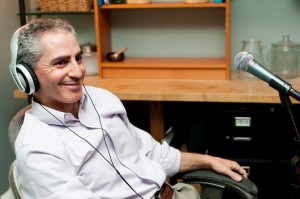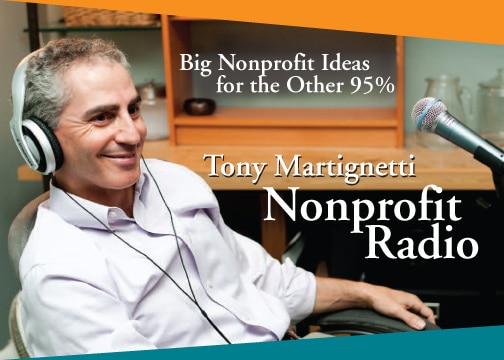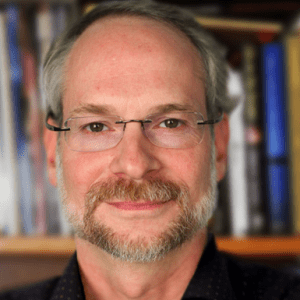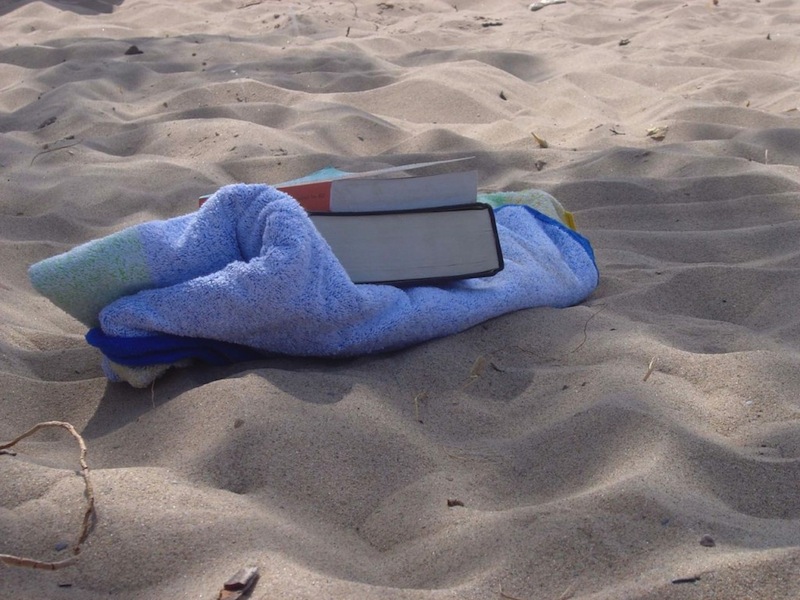Big Nonprofit Ideas for the Other 95%
- On Friday at 1pm: Talking Alternative Radio, Fridays, 1-2PM Eastern
- Listen to the September 13, 2013 archived podcast.
My Guests:
Tricia Napor and Muneer Panjwani: Cause Marketing 101
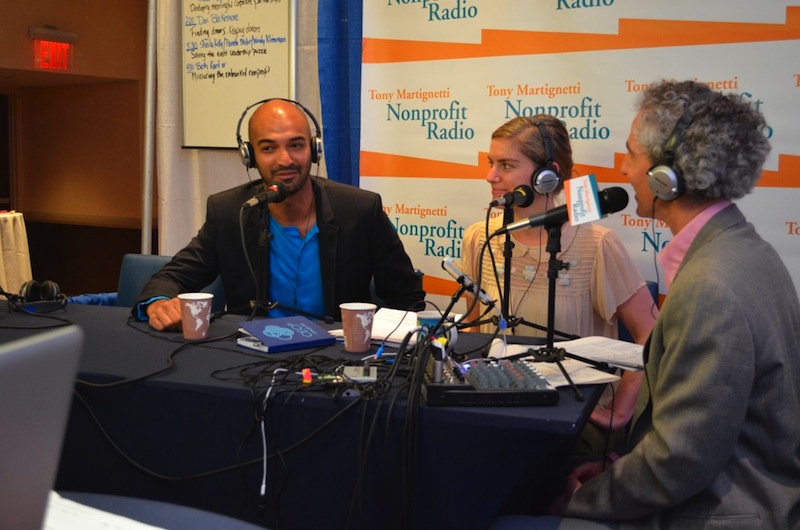
Tricia Napor, principal manager at Alcoa Foundation, and Muneer Panjwani, business development manager for DoSomething.org, share tips for getting started in cause marketing: what it is; what small- and mid-size shops have to offer companies; goal setting; transparency; and aligning missions and needs. Recorded at Fundraising Day 2013.
Scott Koegler: Internal Social Networks
 Scott Koegler, our technology contributor and editor of Nonprofit Technology News, explains how internal social networks complement the external networks like Twitter and Facebook. How to get started, who to invite, and how to promote them. Plus, his one-minute wonderful wine recommendation.
Scott Koegler, our technology contributor and editor of Nonprofit Technology News, explains how internal social networks complement the external networks like Twitter and Facebook. How to get started, who to invite, and how to promote them. Plus, his one-minute wonderful wine recommendation.
Top Trends. Sound Advice. Lively Conversation.
You’re on the air and on target as I delve into the big issues facing your nonprofit—and your career.
If you have big dreams but an average budget, tune in to Tony Martignetti Nonprofit Radio.
I interview the best in the business on every topic from board relations, fundraising, social media and compliance, to technology, accounting, volunteer management, finance, marketing and beyond. Always with you in mind.
When and where: Talking Alternative Radio, Fridays, 1-2PM Eastern
You can also subscribe on iTunes to get the podcast automatically.
View Full Transcript
Processed on: 2018-11-11T23:01:17.217Z
S3 bucket containing transcription results: transcript.results
Link to bucket: s3.console.aws.amazon.com/s3/buckets/transcript.results
Path to JSON: 2013…09…159_tony_martignetti_nonprofit_radio_20130913.mp3.41626681.json
Path to text: transcripts/2013/09/159_tony_martignetti_nonprofit_radio_20130913.txt
Hello and welcome to tony martignetti non-profit radio big non-profit ideas for the other ninety five percent for friday, september thirteen i’m your aptly named host oh, i hope you’re with me. Last week i’d be forced to endure him okra mathos iss if it came to my attention that you had missed the overhead myth letter signers written to the donors of america, the three co signers of the letter are the ceos of the better business bureau wise giving alliance guide star and charity navigator. I dubbed them the three tenors of charity evaluation art taylor, jacob, harold and ken berger and explained what led up to the overhead myth letter, why it was necessary and why they feel many charities should spend more on overhead, then good overhead, bad overhead. Jean takagi are legal contributor helped you understand what may be sensible and appropriate non-profit graham expenses for your non-profit and what you should avoid, how to protect your board officers and employees, but not go overboard on overhead gina’s principle of the non-profit and exempt organizations law group this week cause marketing one oh one, trish in neighbor, principal manager at alcoa foundation and mounir panjwani business development manager for do something dot org’s share tips for getting started in cause marketing what it is, what small and midsize shops have tto offer their corporate partners gold setting, transparency and aligning missions and needs, and that was recorded at fund-raising day twenty thirteen last june, and internal social networks scott koegler, our technology contributor and the editor of non-profit technology news, explains how social internal networks like your blawg you are blogging, right? Compliment the external networks like twitter and facebook. Also his quick wine recommendation between the guests on tony’s take two my block this week is there is no shortcut to getting planned gif ts here’s my interview with tricia naper and muneer panjwani on cause marketing welcome to tony martignetti non-profit radio coverage of fund-raising day two thousand thirteen for at the marriott marquis hotel in times square, new york right in midtown and with me now, teo, talk about cause marketing are tricia neighbor she’s, principal manager with alcoa foundation, and mounir panjwani, business development manager for do something dot orc tricia mounir, welcome. Thank you. Thanks for having us times a pleasure. Pleasure. Nice and quiet here now some of the other recordings have not been this silent. We got lucky s o. Everybody will be very attentive to you. No background noise, let’s, let’s. Define this cause marketing and distinguish it. Maybe from sponsorships or some other things. Tricia, i want to start. What are we talking about? Certainly. Well, so at i work at alcoa foundation, which is the ah charitable arm of alcoa incorporated the aluminum company, which is mostly a business to business company. So we don’t do a lot of marketing. The foundation does a lot of wonderful social programs. And when you look at the issue with this particular partnership with do something was focused on is recycling when you look at the bismol recycling rates of aluminum in the u s you realize that you there’s an awareness problem that people don’t know about the importance of recycling and the amount of impact on the environment that recycling has. So we went, we started looking at ok. How do we really increase increase awareness? A cz well as access and incentives to this. And then ah, oui. I heard that ceo of do something speak and was blown away by the reach that they had with young people. And we really wanted find a way to reach young people with this important message. So that’s how this caused cause marketing campaign began. All right, mounir, why don’t you explain? What do something is? Get let’s, get, uh, started their servers on the same day. So do something, dot or it is the largest organization for young people. In social change, we create about twenty five costs campaigns that young people care about. You have about one point. Six million young people that participate with us every single year reaches all actually close to five million people on dh young people we define as anybody under the age of twenty five. So anybody over twenty five is considered an old person, which would make all of us here in old. Okay. And i was going to my question, andi, if viewers listeners would like to know more about do something have had aria finger on who’s the ceo, you’ll find that video on youtube. You also find the podcast on my block at tony martignetti dot com. She was talking about engaging people under twenty five. Got it had to do it. What is cause marketing money, or how do we distinguish this from other relationships we might have with with the corporate side? So a lot of corporate partnerships are often about, you know, like stopping on a logo on a campaign and that’s, usually where that’s usually where stops caused marketing, specifically aligning cos purpose and values to a cause that their constituency cares about or because of the companies, product or service actually impacts in some way. So we’re a fast food industry talking about hunger in the in the country or alcohol foundation, which is the largest producer of aluminum. Talking about recycling makes sense. So parting with a nonprofit organization that has the expertise and the ability to have a major impact in that space and quitting a partnership between the two, the two organizations is what cross marketing it’s. Okay, and that partnership could take lots of different forms slowly. I mean, i see a lot of point of sale. I know that’s, not your relationship, but it could be ok to be solicited back-up now, but point of sale, or or mohr causes like recycling or could be anything. I mean, this is very broad. Topic, right? Oh, yeah. It’s, it’s, it’s, it’s. Incredibly broad. And i think what’s happening now is the now that the spaces has become increasingly competitive. So every single company wants to do a cause marketing campaign, which is great for the non-profits it’s great for the world, however nobody’s trying to be bold yet, right? So they’re very few cause marketing campaigns are bold enough that they stand out from the crowd. So the challenge, their concern for latto non-profits is what big ideas do we have to separate ourselves from all the other ones? And, yeah, i suppose we are. A local organization. Doesn’t have the reach of do something, you know, five million constituents paying attention. What? What can that smaller to mid size shop offer? Well, the one thing i would advise him on is find out what your unique identity is, right? What a unique asset. So what’s one thing that you bring to the table that nobody else can, and it could just be an idea. It could be an expertise in a space it could be. It could be a service. It could be stories. It could be something specific that nobody else. Can offer that is valuable to the corporation and i would add, i know that this is about caused marketing, but i think from a corporate perspective, if you’re looking for corporate donors, you do have to take it beyond the marketing and that’s something that do something does really well is that they actually have significant impact. So in addition to getting the word out there and the millions of people who are listening to what do something is saying, they also had fifty thousand youth actually go and recycle fifty cans for this campaign, and then we can measure that and say, the results of this of this of this program were this on the environment and this many youth actually participate in the program, so for smaller non-profit that’s looking at caused marketing toe also look beyond just getting the message out, but is there a way that you can quantify the results in the impact of your programs on the community around the environment? Okay? And i’d say within the past, like four years or so, we’ve been hearing a lot more about four to five years, a lot more about impact measurements we need to quantify our outcomes and not just say it’s, good work, but but prove it definitely. So now how about for the smaller shop? Does it make sense for ah, smaller midsize non-profit to approach a company like alcoa? Or should they mawr have their sights set on something smaller, maybe more local to their community? What do you think? Well, i think it does make sense to approach a company in your local community. So, for example, alcoa foundation or an endowed foundation, we have a budget of about twenty five million every year, but we take half of our budget and give it to our local offices all around the world, so they have budgets that range on the amount of employees that are at that location. They might range from thirty thousand to three hundred thousand dollars a year that they give to local non-profit partners. And if a local non-profit partner in one of our facilities in iowa or california went to them and said we could do a really great cause marketing campaign that would also have significant impacts than definitely our local people would probably want to know more and potentially fund that partner, okay? And are you able to speak to what those local the company’s offices would be looking for? Yeah, well, specifically with alcoa foundation were focused on education and environment because there are two key themes that aline very much with our business. And so under the environment, we look at projects that reduce the use of natural resource is and reduce waste that recycle primarily aluminum and that also replenish so a lot of different tree planting in biodiversity programs. And then on the education side, we’re very much focused on stem education, science, technology, engineering and math. I’m sure your parents know what that is. Well, maybe not down. And i have drug in jail on the show. So if if you hadn’t defined it, i would’ve put you in georgian jail. Okay? And then i quickly quickly paroled. We also look at a lot of work force development specifically around manufacturing. Okay? And more generally, it sounds like i mean, the advice would be aligned. Find the company that aligns with your work. Exactly. Find a company. Fight like men when you’re sad. You know, find what your unique offerings are. Do your research. Find what? The company’s. In your local area are focused on check online to see what other kinds of partnerships they have and then come in, prepared and have a good conversation. Okay, let’s, talk about the preparation in here. How do you how do you make that first contact once you found some some good prospects stalking them? That’s the first thing on twitter is like talking about it, google them watch the videos, learn about the companies which is you can learn about the other, the partnership that they’ve made and the success they’ve had in the failures that they’ve had so often times you will look at a company that would say, you know, we had three thousand people like our facebook patient will say, well, what’s the impact of that right? And they might not have an answer to that. So when i sent an email out, i’ll say, you know, you had three thousand people like a facebook page, what? What was the impact? I would love to know what the impact was and if you don’t have one like we love to talk to you about, how can increase that number, not just a number, but actually engagement. Number right. So a tte the parties with alcoa came about after nancy, our ceo, spoke at a conference last year, and the conversation was little patricia restart to us, saying, you know, we loved her speech. We want a partner, seems like you guys to do it right. You guys know what you’re doing, and you’re the expert in your space, and the brand is really, really exciting and engaging, and they were trying to reach a youth market also, yeah, well, let’s, continue that that that threat, because it’s, not just enough to be on social media on dh tout numbers. Those air, you know, sort of vanity metrics, absolutely number of likes. Number of followers of a number of connections on linkedin, talking alternative radio, twenty four hours a day. Do you need a business plan that can guide your company’s growth? Seven and seven will help bring the changes you need. Wear small business consultants and we pay attention to the details. You may miss. Our culture and consultant services are guaranteed to lead toe. Right groat. For your business, call us at nine. One seven eight three, three, four, eight six zero foreign, no obligation. Free consultation checkout on the website of ww dot covenant seven dot com are you fed up with talking points, rhetoric everywhere you turn left or right? Spin ideology no reality, in fact, its ideology over in tow. No more it’s time for action. Join me, larry. Shock a neo-sage tuesday nights nine to eleven easter for the isaac tower radio in the ivory tower will discuss what’s important to you society politics, business it’s provocative talk for the realist and the skeptic who want to go what’s really going on? What does it mean? What can be done about it? So gain special access to the ivory tower. Listen to me very sure you’re neo-sage tuesday nights nine to eleven new york time go to ivory tower radio dot com for details. That’s. Ivory tower, radio dot com e every time i was a great place to visit for both entertainment and education. Listening. Tuesday nights nine to eleven. It will make you smarter. Hey, all you crazy listeners looking to boost your business? Why not advertise on talking alternative with very reasonable rates? Interested simply email at info at talking alternative dot com dahna let’s, uh, i had a guest earlier talking about linc dane and the corporate pages. What is what is ah, do something dot org’s do around linked in. Well, forcing it the founder of lincoln is on the board, so we sometimes have to be oh, there you go. Read happens on a board. Okay, then he spent hours. He’s been a huge support, but for from organization perspective, we have a page on it, and we usually post a lot of the things that are useful for prospective employees. Anybody that’s looking for internship? Our job on the side is their information. Is there? The other thing is nancy serves as one of the writers, so she has, i think, closed down about twenty thousand ceo seo yeah, so she’s, always riding pretty pretty sort of engaging in and fun articles about to do something culture, but also how to advise other smaller non-profits on how to do it, right? Right. So some of the learning that we’ve learned she’s very willing to share that in a very fun and sort of uncensored, weighing a lot. A lot of times, tricia, i think there’s going to be great value. If if you can share what the i’ll call foundation might have done in its research before it approached, do something so heard, nancy speak very engaging sounded of threshold level appropriate, right what’s the next step before you actually spoke to them? Well, eso how cold foundation’s been around for sixty one years, so we just have a lot of experience in working with different non-profits i had heard of do something dot org’s previously, and some of my colleagues had actually gone to their fundraiser the year before and said it’s organizations really fun they actually had their their fundraiser this year, two nights ago when we went back, and it is really fun it’s kind of unlike any other organization, especially just because they’re so focused on youth that that culture pervades everything that they do. So i had heard really good things about it on and then when i heard nancy speak, the thing that she said that really stuck out in my mind and in addition to her colorful language, which you don’t often hear of these conferences that we attend, is that the non-profit incorporate corporate partnerships. It’s a true partnership that the non-profit is not a vendor but their partner, and that has to do something. They have a lot of assets, they have a lot of expertise, they have huge constituent group on dh there, bringing that to the table, and what is the corporation bringing to the table and what are the unique needs and assets of both groups? And i love it when non-profits think that way when they don’t see themselves as a vendor, but as a true partner and that they can enhance what we’re trying to do on education and the environment. So hearing that and hearing that philosophy was pretty much enough, but of course we do our homework. We checked charity navigator and guide star and things of that nature is important for charges to hear it, to make sure that there are legitimate group and then actually are grant application processes pretty thorough, and they have to supply a lot of different information to show they’re financially stable and they have to share with us the list of people on their board of directors on and things of that nature so that we can verify that they’re not affiliated with any terrorist groups and things like that. So we do our homework. So? So before this relationship became was closed, they had to do a grant application. You know, this was not a great relationship that this was a great relationship. Yeah. Okay. Oh, i see. All right. All right. Um did it doesn’t go any further. Are there any? Is there any employee engagement? Definitely way worked. Everything that we look at we look at can we got our employees engaged. So the website that do something put up for us on fifty cans that had a lot of information about the benefits of recycling, i worked with our chief sustainability officer and our other experts in house at alcoa, on recycling on getting some really fun stats for people so the youth could go and see. Oh, wow. When i recycle it saved this. It saves this much energy. Or if i recycle this many cans, i save enough energy to fly to cancun for spring break and things like that. And we all work together on that. That was fun. And and then we turn and know it out to all of our employees saying if you have kids at this age group tell them tio participate and a bunch of them did because there was a five thousand dollar scholarship prize. Didn’t end up going to one of our employees. Children, which was good. You know, we want to spread the wealth, but but we did hear that a couple of our employees encourage their children to apply. And they were getting really into it and looking up where the different recycling facilities were in their towns and things like that. Okay, so yes, definitely went much deeper than the money. Yes, it always does. For us, we look at, you know, the the grant and we want to have the results. But we really want to be engaged and share our expertise as they are with us and money you want. You sound like you want to say more about that. I was going to just go back to the part about partnerships. I think. Do something you know has a very specific philosophy in partnership, which is that, like a partners have to be fun, that they just have to know how to have fun way we know that partition partners is not between organizations there between people. Right? So just like hanging out, patricia on the other night was really, really fun. And nancy, our ceo has always says if you make any any of her staff members cry will cut off the relationship that’s like it’s, like that’s the end of it. And i think i think that speaks really loudly to how how a lot of operatives don’t work, which is like hell bent over backwards to do whatever they can, even if their employees are unhappy. One of the projects not going so well are to make sure that you get the money, which is not the right way to go, because, you know, the part of just will. And as soon as that the program ends right, and we want to make the partners go on for as long as possible. And for that to happen, of forcing that it’s happening, their status meant honest conversation on the table. About what exactly? We’re looking for that big old setting that are realistic goals are in place, and we both understand that we can actually reach them and have our assets in place on the table, not saying that l krauz giving us money. And we’ll just take the money and do what we want with it, but really engaging, i’ll call in to the conversation about well, what can you what else can you bring to the table? And lastly, communicating with them continuously throughout the campaign about the progress off the campaign? So they were a couple challenges in the middle of the campaign where way we’re hitting the numbers because we weren’t getting the report back from the young people. So we told way said that to you. Trish ensues and her colleague about what was going on, and they were very honest about their, like, well, let’s think about other ways to engage our audience even more, and we pivot or just a little bit, but put together when you strategies and ended up getting one point, three million cans collected by about eleven weeks. No, that was that was the whole campaign was all gonna be okay. All right? So i see the nature of a true partnership sharing the fact that things are not. We’re not meeting targets and let’s collaborate about how we can we can make that make that change. And the other thing that was helpful from my point of view is i was looking for innovative recycling projects on dh. They came in and they had their template. This is who we are. This is how we run campaigns. We send out this many tax messages, this many emails, we set up the website, and then, you know, we just kind of to some degree plug and play the recycling messages into what we already dio. And we can show you the success that these campaigns have had on other subject areas. And so it was not like reinventing the wheel, although it felt so specific to us. And they really did hear what we were saying, where our main goals of the campaign and we far exceeded. I think we exceeded our cola foundation’s goals. And i think we even exceed to do something it’s goals. So it was the success for sure, it’s part of your seminar topic is avoiding some of the possible negative consequences. I know when here you mentioned communication being critical, what other ways might we avoid problems in these in these cause marketing relationship, i think transparency in every single wife. So transparency in any of the challenges that we’re facing a transparency and asking for help when we need it. So when we you know when when alcohol wanted to engage the employees, they they said, we need to engage employees, and we need to make sure that this campaign is open to the kids over employees. And he said, ok, that’s great. So here’s the messaging that you can send out the employees that’s going that they can pass on to their kids to get them involved in the campaign. S o i was a transparency is one of the biggest ones, because a lot of the initial reaction for anybody that’s in trouble is to hide the fact that something is wrong, right on dh we are always always honest because i mean, honesty breeds more honesty and honesty. Bill’s good relationships so that’s why i think that’s one of the reasons why most of our responses keep coming back to work with us, it’s because we never tell them something that they don’t have something that they just want to hear, we tell them, what’s the truth and i would say also with some cause marketing campaigns, you could have something occurred that might look like green washing or might look like, oh, we’re just marketing something. And what was successful about this campaign was we had a lot of stats and a lot of data from alcoa about the importance of recycling, and we know a lot of people have heard of you should recycle you should recycle, but i think that we frame the message in a really compelling way and do something worked with us, how i mean holding our hands, saying, ok, that message is appealing, but to appeal to this age group, you could just tweak it like this, and then people would really like it. So they helped us with our language and things of that nature. And i think for successful cause marketing campaigns, you want to make sure that the cause is clear and that the impact of what you’re trying to get people to do is clear. Okay? Meunier mounir, we you mentioned goal setting. You do that? I’m sure is a collaboration, both both there’s to be a two way street, right? Both sides need to benefit. What was the what was the main benefit for? Do something or some of the benefits. Do something it’s literally lives on data. We have two chief data people on staff, so all they do is crunch Numbers to figure out 1 what? What causes people care about and and what what campaigns we should be planning a number two was a measuring the impact radcampaign so, like he said, cause marketing campaigns usually are really hard to measure, and they’re usually measured in just media precious, right? We got a million media pressure, but that’s about it. But what about the number of people that you reach that actually took action over you of this campaign? So we have a very sophisticated tracking mechanism with our members, so every time somebody signs up on our website or signs of being mobile, we can we can track that every time somebody reports back, we contract because we have their cell phone numbers, we can track the locations where they add their age group, the high school, that they go to their demographics. All that data is that we have so we can at the end of the campaign, we can figure out exactly who participated in the campaign, which is incredibly, incredibly useful for any corporate. Partner on that. And we also know that, like, numbers tend to nam in stories into stick, so don’t number is going to be huge. We always find one or two stories that are really, really meaningful impact to share, too sort of to to, to me to make the numbers more colorful. Underlying one year’s discussion was spinning of the wheel in the jason booth. So, for listeners are, or even watching video, you’re not seeing this wheel’s been, but there’s, a company that we’ll let you spend it, we don’t take a chance at winning mug t shirt kapin or ah, and i paid many drawing entry, so that’s, what that’s, what you’re hearing let’s, see. Tricia let’s, let’s, leave. We just have a like a minute and a half for shoulder let’s. Leave small and midsize non-profits with the first step. Really tio engaging in this kind of relationship with company? What should they should be thinking about first, um, i would go back to what muneer said it. No, i know what it is that you do that is unique on look at who your audience is and who your constituents are that you have access to and then really clarify that. Say, these are the people who are following us on twitter. And we have this many facebook people and we have this many people that we can reach. You read our newsletters, etcetera. So if you work with us on this cause marketing campaign, this is how many people you would reach. And then also be sure that there’s something what’s great about this is that do something. People cycled fifty cans. Then they went online and they said i recycled fifty cans. They got put in a lottery to win a five thousand dollar scholarship so that data that he was just talking about, we can actually say fifty one thousand use recycled one point three million cans, and that is something that you, the corporation’s really do want. They really do want those metrics. Okay, excellent. Thank you both very much. Thank you, tony. My pleasure attrition. Naper is principal manager for the alcoa foundation and mounir panjwani is business development manager for do something dot org’s. Thanks again, tony martignetti coverage of fund-raising day two thousand thirteen. Thank you very much for being with us, thanks to everyone at fund-raising day, the organizer’s there for helping me set up and work the logistics of getting all the terrific interviews that i got that day back in in june, we’ll go away for a couple seconds. When we come back tony’s take to there’s no shortcut to plant e-giving and then scott koegler on your internal social networks. I hope you’re blogging. Stay here. They couldn’t do anything to getting dink dink dink dink. You’re listening to the talking alternative network get in. Nothing. Good. Are you suffering from aches and pains? Has traditional medicine let you down? Are you tired of taking toxic medications? Then come to the double diamond wellness center and learn how our natural methods can help you to hell? Call us now at to one to seven to one eight one eight three that’s to one to seven to one eight one eight three or find us on the web at www dot double diamond wellness dot com way look forward to serving you. Hi, i’m ostomel role and i’m sloan wainwright, where the host of the new thursday morning show the music power hour eleven a m we’re gonna have fun shine the light on all aspects of music and its limitless healing possibilities. We’re going invite artists to share their songs and play live will be listening and talking about great music from yesterday to today, so you’re invited to share in our musical conversation. Your ears will be delighted with the sound of music and their voices. Join austin and sloan live thursdays at eleven a m on talking alternative dot com you’re listening to the talking alternative network. I’m leslie goldman with the us fund for unicef, and i’m casey rodder with us fund for unison. You’re listening to tony martignetti non-profit radio big non-profit ideas for the other ninety five percent. I can’t send live listener love this week because we’re pre recorded, but i do love all the live listeners and, well, we know the standard the regulars who check in all the time north carolina, california, texas, new york, new york has been checking in. And, of course, all our asian listeners probably very good chance south korea, japan and china live listener loved to each of you and podcast pleasantries always gotta remember the thousands of you who are out there listening to the podcast. Thank you so much time for tony’s take two my block this week is there is no shortcut to plant e-giving i have been seeing recently on twitter and some email marketing and promotion messages that i get people suggesting that there’s quick ways to get planned gif ts these are, of course, gif ts from people’s state and retirement plans it’s the work that i do in consulting that’s that’s, my fund-raising niche is planned e-giving um, there are plenty of quick ways to promote planned gif ts, but there aren’t quick ways too close planned gif ts i list on the blogged a bunch of about a dozen ways to promote plant giving very quickly, like just a nisi short sidebar in a newsletter or in an e mail blast, adding a checkoff to your year and reply cards, adding a check off to the back flap the of all your envelopes um, and they said, list about a dozen in this in the in the block, those air quicken and cheap ways of promoting planned giving but closing the gif ts that takes time because these air gif ts that require lots of personal thought and personal factors going into the decision. Think about your estate planning your retirement plan. The the most basic example is a gift in someone’s will what would it take for you to include a charity alongside your husband, wife, children, grandchildren? That takes a lot of thought? You don’t just do that because you got an e mail blast so there’s no quick route to closing these gif ts and that’s what i’ve been objecting to that i’ve been seeing on the on the social networks and in my email lately, the block post is called there is no shortcut to plant e-giving my block is that tony martignetti dot com, and that is tony’s take two for friday, thirteenth of september thirty seventh show of the year. Scott koegler returns he’s the editor of non-profit technology news, which is that n p tech news dot com on twitter he’s at scott koegler. Scott koegler welcome back! Hey, tony, thanks a lot, it’s a pleasure to have you it’s a pleasure to be had. Thank you. I just gave you a shout out for twitter, but something very disturbing has come to my attention since you were on last you are not following me on twitter, is that right? Believe possible? You believe that? I don’t know i’d like to ask you that question you’ve been on for. Ah, just about probably this has been like three years on the show. I tried to send you a direct message and, uh, i couldn’t do it. You are not following me on twitter, let me see here alright, you’re you khun you khun rectifying martignetti there. There you are and yeah, look at that. No following, thank you very much. I think i was going to say you could take care of it after the show. But thank you for resolving that. Okay, that’s the end of the official admonishing, wait, we’re talking about the internal sense social networks, which can complement the external ones like facebook and twitter, right? Absolutely. And, you know, there’s been so much talk about, obviously about social networks, facebook, twitter, google plus, you know, ad, ad nauseum and, you know, those were great, but and they they are useful, and in connecting with people that you may not know, that your friends may know, or that your associates may know so it’s a good way to reach out, sure, right? Um, the good part about that is that is that it can expand your fear, events, your sphere of influence. But the bad part of it is that that bleeds over into possible competitors. Er, um, you know, competitors, organizations that may also be friends with other people that you are friends with, that your friends are friends with, you know, how that goes, right? So it works both for and against you, no. So that said it’s, something that he really can’t ignore and you should certainly be posting to and participating in all right, but the whole point of internal social networks is that it’s i don’t want to call it a captive audience, but it’s more of ah, well, it’s, internal, it’s, it’s something that is within it’s, usually attached to your website and it’s kind of internal club that people that are interested in what you’re doing are participating with okay, short definition. Okay, we’ll talk more about this internal club. What are the advantages of setting this up internally to complement the external well, the advantages that you can you have control over over the messages that are being sent now that you don’t have control over the messages in your in your facebook princeton’s, but if you post something on your own website, the internal social network, then you know that at least the people that are that are participating in that are going to get your message. Additionally, that message can be then reposted, and a lot of the systems that are available for internal social networks will automatically take your posts from the internal network and re post them to twitter, facebook, google, plus and whatever else. So you’ve got this kind of ripple effect going out, okay, um, isn’t there? Ah, ah, also a reason to do this because you can capture data about the people. Sure, sure, you know, facebook profiles are great because you know, they’re they’re available, but they’re very generic, right? You look at my facebook profile, it just kind of says who i am and what i like. I wouldn’t know what it is. We’re not. We’re not friends on facebook. Yeah, you know, when i when i saw that, they’re not when i saw that you don’t follow me on twitter, i unfriended you on facebook. Not that i think we’ll be following you on twitter. All right, not that i’m vindictive, but i i’m vindictive. Okay, i got it. I don’t want you to think i’m vindictive, okay, but so is a okay, go ahead. I know you know, i know them. All right, so facebook is yeah, there’s so much you can learn about someone on facebook, okay, right, but if if you have a social network internally to your system and to your organization than the profiles on people generate, there are much more specific they will talk about, you know, how they’re involved within your organization, and so it kind of brings things closer to what what your organization is about. People will say, well, i went to this particular event, or i helped with this project or i i’m participating in such and such and so it’s much more, more focused, you get people a better view of what’s going on within your organization on also branding, right? You have total control over the way this sight is going to look, absolutely, and you can take some of your, uh, good way to get to get participation is there is to take some of you block post opposed internally on your site and offer those up as questions or or request for commentary through your internal social network. Those then post out to your facebook your twitter, whatever else, right? And as people see that, whether there, um whether they’re currently on your internal network or not, when they click on those the comment that click should and they don’t always but, uh, if you look at the facilities that are available, who should bring you directly back into your internal social network for comment? So it’s kind of ah, you know, it’s reaching out and pulling in is what it’s doing? Ok, now you said block posts would go to your your internal network. I thought we were talking about blogging. We’re talking about something different than your organization’s blawg when we talk about this journal club, correct? We’re talking about a a way for people to communicate to each other, not a blob. Blob, you know, is an external in an article that was posted that then goes out, um, there’s a there’s. A really good example of an internal social network that’s done by sales force. Self a link for you, sales force foundation dot or ge? Okay, uh, you know, i’m not really promoting sales force, although i think it’s a it’s a great tool. Uh, that sales force is a, uh he’s a manager of contacts. Right. So c r m a contact. Management, not sierra constituent relationship management system. Thanks, but i don’t have time for you to get all your people, your list of people in there, and then they can interact with each other. It also allows you to manage how you talk to folks and what kind of messages you get out. So, yes, it’s different from a block. Okay, so so the concept is you write a blogger and you say, hey, i wrote this block and you posted into europe for instance, sales force or non-profits serum, and that then gets posted out to the people that are currently members of of it. So it goes directly to them. It also gets posted out to your twitter followers and to your facebook followers into google plus followers. So it’s a way of just before kind of reaching out and bringing in. Okay, okay, um and i want to be fair toe sales force that not that they support this show in any way or have any relationship with me. But they do have, eh? A program where non-profits can use up too. I think. It’s up to ten licenses sales force for absolutely free. We’ve had guests on a couple of guests have have mentioned that in the past maria simple is one of them, so we won’t be fair to sales force. They do have a non-profit program on dh, so it does work for non-profits as well. So we have just about a minute or so before we take our first break. What what does it take to get started in creating this? This this club internally? Well, let’s, just take sales for since we’ve been talking about that, since we also know it’s free and it’s probably one of the most widely used managers of of for any kind of internal networking. Uh, just goto salesforce foundation, not order signed up for there will be instructions there on how to integrate that into your website, and it should be connected through your website that’s kind of the whole purpose is so that it brings people back to your website on then start to use it, you know, announce your post your blood articles written on through that, uh, do that system and let it do its job. Okay, if you also want to ask people to join and all that kind of thing, yeah, we’re gonna talk more about bringing in. Some early adopters and things like that. So we’re going to go away for a couple seconds. We come back, scott, and i’ll keep talking about your internal social network. Keep listening that. You’re listening to the talking alternative network. Are you stuck in your business or career trying to take your business to the next level, and it keeps hitting a wall? This is sam liebowitz, the conscious consultant. I will help you get to the root cause of your abundance issues and help move you forward in your life. Call me now and let’s. Create the future you dream of. Two, one, two, seven, two, one, eight, one, eight, three, that’s to one to seven to one, eight one eight three. The conscious consultant helping conscious people. Be better business people. Oppcoll have you ever considered consulting a road map when you feel you need help getting to your destination when the normal path seems blocked? A little help can come in handy when choosing an alternate route. Your natal chart is a map of your potentials. It addresses relationships, finance, business, health and, above all, creativity. Current planetary cycles can either support or challenge your objectives. I’m montgomery taylor. If you would like to explore the help of a private astrological reading, please contact me at monte at monty taylor dot. Com let’s monte m o nt y at monty taylor dot com. Talking alternative radio twenty four hours a day. Bonem oppcoll welcome back, big non-profit ideas for the other ninety five percent or it’s got, um, once we have this, we’ve built this buy-in how do we start to get people to come to it? Well, the old fashioned way and ask them and you can ask them in the same manner that you would, uh, post a blonde post onto your internal social network simply hey, we’ve got this new thing and we invite you to join our club it’s probably say it better than i just said it, but, uh, you post that out, it would go out to your two or three people that you’ve got internally and they’ve got to your to your facebook, twitter, google, plus but there’s one other trick that probably is a better way to handle it and at least a good way to get it started and that is to go to your people that are currently participating with your organisation in other ways and simply ask them to be pilots for for this, for this new venture that you’re putting together, just ask them to join asked them to comment and ask them to invite their friends, you know peer-to-peer usually more effective than just kind of a blind invitation. These are the people who are the most active in your existing networks, right? Exactly. Okay, um, and as your as you’re promoting this and inviting people to come, you need to be sharing what? What the value is, why they should spend time with you, right? And hopefully that’s part of what goes on in your blondes because that’s really the topic anyhow, what are we doing? Why is it important to the world? Why’s it important to you? And maybe it will take one or two sentences as a preface to that block post to say, you know, here’s, something new we put up, we really think this is important. Please come here and read it. And while you’re here, please join our into our internal network of conversations as we are ongoing promoting this durney we need to be listening back to the community right for feedback, right? And and that’s really no different again from what you would do with twitter, facebook, right? Well, plus you certainly want to interact and that’s the whole point. And if you’re trying to concentrate your efforts to your internal social network and provide, uh, even better interaction there. You should be paying at least a little bit more attention to the internal than you would be to your external. Of course, you know, it all kind of balances out. You don’t want to ignore anyone, but you always want to say, you know, please come, join us here rather than out there. Yeah, you have, ah, article, that is a couple of years old, but it talks about this very, very, uh, thoroughly and there’s. Also, ah, suggestion of another place. Besides what you had suggested, sales force that will help is a platform for setting these up. The right but i can’t seem to remember which wanted what which one they’re talking about, but you obviously dio advanced solutions international? Uh, right, right. Of course, it’s a d v s o l dot com. So i like to give, like, to give listeners a couple of choices. What else? What else you wanna tell us about these thes internal networks that i haven’t asked you about? I think the message is that they’re adjunct to the one two what you’re already doing. And and in some ways that probably putting one of these together probably make your social media life a little bit easier because it is, and it should be the starting place for all social media conversations you can post there and have it automatically post out to your other social networks, which means you’re not going to everyone of your social networks and posting, uh, crusher probably is in some kind of some kind of tool to automatically post anyhow, but this this is one place to concentrate on again will bring things back together into your eye. Your designated location? No, i guess that’s really the most of it. But overall it’s going? To help you to concentrate your constituency on the things that you think are more important and toe let that conversation build internally rather than just kind of out in the wild. Okay, and then you also have the advantage of finding out more about your people as we talked about, right? As they develop their profiles, you get learn more about them and you can then contact sales force again is a great tool to do exactly that because i mean that’s the whole point of sales forces knowing who you’re dealing with, knowing what their last interaction was, knowing what they’re interested in and then being able to communicate directly with him. Okay, we got just enough time for you to give your quick wine recommendation. What? What is it? All right. I have wanton it’s, a california wine it’s, an alexander valley cabernet sauvignon it’s a two thousand ten and it’s been one of the one of my most consistent, highly rated it’s under under twenty dollars. Generally seventeen dollars, or so. And you can get it a lot of places. Total line wine warehouse. Those kind of places. Ok, say it one more time. What is? It alexander valley cabernet sauvignon the one i like is the two thousand ten okay, scott koegler are non-profit technology contributor, editor of non-profit technology news, which is that n p tech news dot com he’s at scott koegler on twitter my newest follower and the article that we talked about this at at and p tech news dot com is called non-profit social media smarts, internal or external social networking tools. Scott koegler thank you very much. Thanks, tony. Take care. My pleasure. Thank you. Next week. Maria semple is back. She’s our prospect research contributor. She reminds us that newspapers and magazines are valuable prospect research tools. They sound like they’re very nineteen, ninety nine, but they can be valuable and she’ll explain why if you like this show, then you’ll love my podcast for the chronicle of philanthropy. It’s called fund-raising fundamentals it’s monthly and it’s ten minutes it’s on the chronicle of philanthropy website and it’s on itunes. Our creative producer is clear miree off. Sam liebowitz is our line producer shows social media is by deborah askanase of community organizer two point oh, and their remote producer of tony martignetti non-profit radio is john federico. Of the new rules that music i hear in the background are music is by scott stein. I hope you’ll be with me. Next friday, i’ll be back live in the studio. On the twentieth of september, we’ll be at talking alternative broadcasting at talking alternative dot com, one to two p, m eastern. Oppcoll didn’t didn’t. Didn’t dick tooting. Good ending? You’re listening to the talking alternate network, waiting to get you thinking. Are you a female entrepreneur? Ready to break through? Join us at sexy body sassy sol, where women are empowered to ask one received what they truly want in love, life and business. Tune in thursday, said noon eastern time to learn tips and juicy secrets from inspiring women and men who, there to define their success, get inspired, stay motivated and defying your version of giant success with sexy body sake. Soul every thursday and me in new york times on talking alternative, that calm. Are you suffering from aches and pains? Has traditional medicine let you down? Are you tired of taking toxic medications, then come to the double diamond wellness center and learn how our natural methods can help you to hell? Call us now at to one to seven to one eight, one eight three that’s to one to seven to one eight one eight three or find us on the web at www dot double diamond wellness dot com. We look forward to serving you. You’re listening to talking alternative network at www dot talking alternative dot com, now broadcasting twenty four hours a day. This is tony martignetti aptly named host of tony martignetti non-profit radio. Big non-profit ideas for the other ninety five percent technology fund-raising compliance, social media, small and medium non-profits have needs in all these areas. My guests are expert in all these areas and mohr. Tony martignetti non-profit radio fridays one to two eastern on talking alternative broadcasting are you concerned about the future of your business for career? Would you like it all to just be better? Well, the way to do that is to better communication. And the best way to do that is training from the team at improving communications. This is larry sharp, host of the ivory tower radio program and director at improving communications. Does your office need better leadership? Customer service sales or maybe better writing are speaking skills? Could they be better at dealing with confrontation conflicts, touchy subjects all are covered here at improving communications. If you’re in the new york city area, stop by one of our public classes or get your human resource is in touch with us. The website is improving communications, dot com that’s improving communications, dot com improve your professional environment. Be more effective, be happier. And make more money. Improving communications. That’s. The answer. Talking. Hyre
